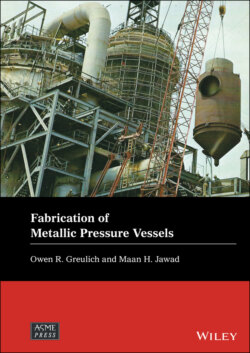Читать книгу Fabrication of Metallic Pressure Vessels - Maan H. Jawad - Страница 31
1.4 Fabrication of Nonnuclear Versus Nuclear Pressure Vessels
ОглавлениеThe fabrication of nuclear components such as vessels, pumps, valves, piping, and storage tanks in the United States must meet the requirements of Section III Division 1 of the ASME Boiler and Pressure Vessel Code as well as the rules of the U.S. Nuclear Regulatory Commission (NRC). This book is written for nonnuclear applications. While the general fabrication processes such as forming, machining, and welding are the same for both nonnuclear and nuclear components, the quality control process is different regarding the details of these operations.
Nuclear components constructed in accordance with the ASME code are considered in “classes” that are used to construct pressure equipment in accordance to its relative importance to safety. The three most common classes are Class 1, 2, and 3.
Class 1 components, including vessels such as reactor vessels, pressurizers and the primary side (tubes) of steam generators are exposed to radioactive coolant fluid, and they consequently are considered to bear the highest importance to safety. Class 1 vessels therefore require the most stringent levels of quality control for the various fabrication operations, compared to Class 2 and 3 vessels. Class 2 vessels generally resemble ASME VIII‐2 (editions prior to 2007) requirements, while Class 3 components are generally similar to VIII‐1 requirements.
All three classes of nuclear components are subject to strict quality control during construction. Quality assurance requirements for nuclear applications are provided in Article 4000 of the ASME Nuclear Code Subsection NCA (General Requirements for Division 1 and Division 2), along with its references to ASME NQA‐1 (Quality Assurance Requirements for Nuclear Facility Applications, Part I and Part II).
Some of the details required during fabrication of Class 1 nuclear vessels, pumps, valves, and piping are as follows:
1 All materials must be provided with documentation showing Certified Material Mill Test Reports. The location of the test specimens taken from the mill plate must be identified for traceability. When a piece of the mill plate is cut out for use as a vessel part, its location in the mill plate is recorded and identified. Depending on the material, the method of removing the plate, such as machining or burning then grinding, may need to be recorded. The type and identification number of the grinding wheel may also need to be recorded. These requirements must be met for each piece of material in the pressure vessel.
2 Hot forming during fabrication must be qualified and documented. The effect of hot forming on material properties and final thickness for some materials may have to be recorded.
3 All weld electrodes and wires must be identified, including recording of heat numbers, location where used, and properties, with full documentation and traceability.
4 Each weld in the vessel must be identified with regard to the location as well as WPS and PQR.
5 All weld repairs on materials and welds during fabrication must be identified and documented. Such documentation must include weld procedures and their effect on properties such as strength and impact values.
6 Examination of welds and components must be documented.
7 Records of operators, equipment used, calibration of equipment, and results of tests must be maintained.
This limited sample of Class 1 requirements illustrates the extent to which quality control and documentation required for nuclear components exceed those for nonnuclear components.
